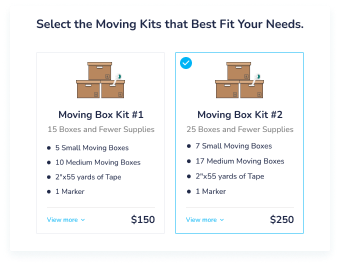Moving Boxes
A successful move means getting all the right supplies beforehand.
Buy a moving kit with iMoving and get everything you need in one easy package.
Boxes Made Better with iMoving
 1
1
Tell Us the Details
Let us know where to send the goods. No pickup necessary.
 2
2
Choose a Moving Kit
Pick and choose a custom-tailored bundle of moving supplies.
 3
3
Make Payment
Make your payment, and we’ll send you your moving supplies right away.
 Box Sizes
Box Sizes

Small Cardboard Box


Out of all the boxes you’ll need, you’ll probably need the most small cardboard boxes. These are a pretty useful option for all those small items you have a lot of, whether it’s books, silverware, or canned food.

Medium Cardboard Box


Medium cardboard boxes are the do-it-all solution for your packing needs. Because of their balance between size and weight, they’re a versatile solution for the biggest range of home goods.

Large Cardboard Box


Large cardboard boxes are great for lightweight, yet large items. Big ol’ stuffed animals, pillows, and puffy duvets. Don’t load these up with big, heavy items - that’s a rookie mistake, and it’ll split the bottom.

Wardrobe Boxes


Wardrobe boxes come with an internal hanging rod to keep your suits and dresses wrinkle-free. They range in height, so make sure you get one that’s tall enough to keep your clothes hanging straight.

TV Boxes


As the name suggests, TV boxes are for your TVs and/or computer monitors. TV boxes come in a variety of shapes and sizes. Measure your screen diagonally from corner to corner to get a rough idea of what size you need.

Telescoping Boxes


These boxes come in two halves: One is slightly larger and fits over the edges of the other. This allows you to adjust the size as needed. Telescoping boxes are great for mirrors and other items that are a little oddly-sized.

Dish and Glassware Boxes


Dish and glassware boxes are a must. They usually come with an internal cardboard support structure that divides the box into smaller compartments. Load your fragile bowls, plates, and glasses up, and flood the box with packing peanuts.

Mattress Boxes


Mattress bags are great for short moves, but if you think you’ll need a bit of extra time to set up that second bedroom, we recommend using a mattress box to prevent your mattress from getting damaged or bent out of shape.

Wooden Crates


Wooden crates may seem old school, but they’re the best option for large and fragile belongings. They provide an extra degree of protection and stability, and your movers may even build the whole crate around the item in question.

Specialty Crating


We’ve had customers with everything from pianos to vintage motorcycles. These obviously don’t fit in a regular-sized (or shaped) box or crate. Instead, your movers may partially disassemble the bits and pieces, or build a custom-shaped box around the item.
 Moving Box Calculator
Moving Box Calculator
Moving isn’t always an exact science, but it can be pretty close. Use our moving Box calculator to see how many boxes you’ll need, and what kind of boxes will be best for your move:
Choose Home/Apartment Size
Small Box10 boxes
Medium Box14 boxes
Large Box7 boxes
Dish Box 4 boxes
Wardrobe Box 2 boxes
Picture Box 5 boxes
Small Box 15 boxes
Medium Box 18 boxes
Large Box 11 boxes
Dish Box 6 boxes
Wardrobe Box 4 boxes
Picture Box 8 boxes
Small Box 22 boxes
Medium Box 28 boxes
Large Box 17 boxes
Dish Box 11 boxes
Wardrobe Box 6 boxes
Picture Box 12 boxes
Small Box 31 boxes
Medium Box 40 boxes
Large Box 25 boxes
Dish Box 13 boxes
Wardrobe Box 9 boxes
Picture Box 16 boxes
Small Box 42 boxes
Medium Box 50 boxes
Large Box 34 boxes
Dish Box 18 boxes
Wardrobe Box 11 boxes
Picture Box 20 boxes
Small Box 54 boxes
Medium Box 66 boxes
Large Box 42 boxes
Dish Box 23 boxes
Wardrobe Box 14 boxes
Picture Box 25 boxes
 Moving Kits
Moving Kits
Our moving kits come with everything you need to Box and pack your belongings. They’re even custom-tailored to the amount of rooms you’ll be moving.
Moving FAQ
Moving boxes come in all shapes and sizes to fit your belongings! Standard options include small (books), medium (kitchenware), and large (blankets).
But there's more! Specialized boxes like wardrobes for clothes, dishpacks for plates, mirror boxes, mattress boxes, TV crates, and even extra-large boxes offer extra protection for your special items.
The exact number of boxes depends on your stuff! Estimate by size (apartment/house) and occupancy (minimalist/packrat). Online calculators can help with a more precise guesstimate.
Choose moving boxes based on what you're packing! Size matters - consider how much weight a box can hold (heavy books vs. linens).
Opt for double-walled boxes for heavier items. Special boxes protect fragile items like mirrors or artwork. For easy stacking and moving, prioritize sturdy boxes in standard sizes.
For example, if you have a lot of small, fragile items that might require single small boxes, you’ll know to stock up on those. We always recommend getting more boxes than you think you’ll need just to be safe!
Steer clear of packing hazardous items in moving boxes! This includes flammables (paint, gasoline), perishables (food), cleaning supplies, and aerosols.
These can leak or explode during transport. Leave valuables like jewelry and important documents with you for safekeeping. Check with your mover about any restrictions for specific items.
You can buy moving boxes from Lowe's, Home Depot, and even Office Depot. Maybe you will be lucky enough to find them cheaper on offer-up websites like OfferUp, FaceBook Marketplace, and eBay.
Absolutely! Eco-friendly options are available for your move. You can rent reusable plastic boxes from services like U-Haul. Cardboard boxes made from recycled materials are another green choice.
For packing materials, consider biodegradable peanuts, recycled packing paper, and cloth blankets instead of bubble wrap and packing peanuts.
You can check out platforms, like Facebook Marketplace, OfferUp, and Craigslist to find free moving boxes. Another good idea is to reach out to friends and family and ask them to save any boxes they have for your move.
Wardrobe boxes keep clothes wrinkle-free during moves! These tall boxes have a built-in hanging bar. Simply move clothes directly from your closet onto the bar.
Assemble the box, hang garments, add light items (optional) at the bottom for stability, secure with tape, and label "wardrobe" for easy unpacking!
For ultimate protection, pack dishes and glassware separately. Use sturdy boxes (marked "glass" if available) and bubble wrap each piece individually.
Fill any empty spaces with crumpled packing paper to prevent items from shifting during transport. Skip packing peanuts – they can crush delicate items.
Go beyond just writing "kitchen"! Label all sides of the box with the destination room (e.g., "Kitchen") and a brief description of contents (e.g., "Pots & Pans").
Consider numbering boxes by room for a clear unloading order. Color-coding boxes by room (red for kitchen, blue for bathroom) adds another layer of organization.
After unpacking, don't ditch your boxes! Reuse them for storage or future moves. Get crafty with DIY projects. Recycle (check guidelines first) or offer them to friends or online for someone else's move!
Pack smart! Use sturdy boxes for heavy items and fill any gaps with packing materials. Lighter items go in bigger boxes.
When stacking, place heavier boxes on the bottom and lighter ones on top to prevent anything from getting squished.
We generally recommend using smaller boxes that fit the item. Heavy items are more prone to moving around inside a large box, so you’ll want to use the most compact box possible.
We recommend avoiding any boxes that have been worn down, or broken. This is because you run the risk of items getting damaged. Stick to intact boxes for your move!
Bins win for durability and water resistance, ideal for storage. Boxes are cheaper and lighter, perfect for short moves. Choose based on your needs!
Out of boxes? No worries! Repack tighter or use soft items for padding. Get creative with suitcases, laundry baskets (labeled!), or duffel bags. Check with stores or online for free boxes to keep the move rolling!
Yes, you can get moving boxes delivered to your home. You can look for delivery services online or from various office supply stores.
Yes! You can rent moving boxes from various companies such as BungoBox, Redi-Box, or ZippGo.
Your Spectrum of Moving Services at a Glance

Local Moving

Long Distance Moving

Truck Rental

Packing Services

Storage Services

Small Deliveries

Commercial Moving

Moving Labor

Car Shipping

Assembly and Disassembly

Disposal Services

Piano Services
